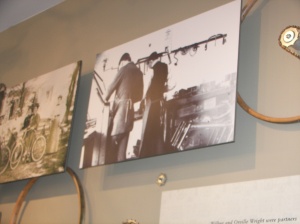
First man made plastic forks.
Celluloid is derived from cellulose and alcoholized camphor. John Wesley Hyatt invented celluloid as a substitute for the ivory in billiard balls in 1868. He first tried using collodion a natural substance, after spilling a bottle of it and discovering that the material dried into a tough and flexible film. However, the material was not strong enough to be used as a billiard ball, until the addition of camphor, a derivative of the laurel tree. The new celluloid could be molded with heat and pressure into a durable shape.
Besides billiard balls, celluloid became famous as the first flexible photographic film used for still photography and motion pictures. John Wesley Hyatt created celluloid in a strip format for movie film. By 1900, movie film was an exploding market for celluloid.
Formaldehyde Resins - Bakelite
After cellulose nitrate, formaldehyde was the next product to advance the technology of plastic. Around 1897, efforts to manufacture white chalkboards led to casein plastics (milk protein mixed with formaldehyde) Galalith and Erinoid are two early tradename examples.In 1899, Arthur Smith received British Patent 16,275, for "phenol-formaldehyde resins for use as an ebonite substitute in electrical insulation", the first patent for processing a formaldehyde resin. However, in 1907, Leo Hendrik Baekeland improved phenol-formaldehyde reaction techniques and invented the first fully synthetic resin to become commercially successful, tradenamed Bakelite.
Timeline - Precursors
- 1839 - Natural Rubber - method of processing invented by Charles Goodyear
- 1843 - Vulcanite - Thomas Hancock
- 1843 - Gutta-Percha - William Montgomerie
- 1856 - Shellac - Alfred Critchlow, Samuel Peck
- 1856 - Bois Durci - Francois Charles Lepag
Timeline - Beginning of the Plastic Era with Semi Synthetics
- 1839 - Polystyrene or PS discovered - Eduard Simon
- 1862 - Parkesine - Alexander Parkes
- 1863 - Cellulose Nitrate or Celluloid - John Wesley Hyatt
- 1872 - Polyvinyl Chloride or PVC - first created by Eugen Baumann
- 1894 - Viscose Rayon - Charles Frederick Cross, Edward John Bevan
Timeline - Thermosetting Plastics and Thermoplastics
- 1909 - First true plastic Phenol-Formaldehyde tradenamed Bakelite - Leo Hendrik Baekeland
- 1926 - Vinyl or PVC - Walter Semon invented a plasticized PVC.....................................>
- 1927 - Cellulose Acetate
- 1933 - Polyvinylidene chloride or Saran also called PVDC - accidentally discovered by Ralph Wiley, a Dow Chemical lab worker.
- 1935 - Low-density polyethylene or LDPE - Reginald Gibson and Eric Fawcett
- 1936 - Acrylic or Polymethyl Methacrylate
- 1937 - Polyurethanes tradenamed Igamid for plastics materials and Perlon for fibers. - Otto Bayer and co-workers discovered and patented the chemistry of polyurethanes
- 1938 - Polystyrene made practical
- 1938 - Polytetrafluoroethylene or PTFE tradenamed Teflon - Roy Plunkett....>
- 1939 - Nylon and Neoprene considered a replacement for silk and a synthetic rubber respectively Wallace Hume Carothers
- 1941 - Polyethylene Terephthalate or Pet - Whinfield and Dickson
- 1942 - Low Density Polyethylene
- 1942 - Unsaturated Polyester also called PET patented by John Rex Whinfield and James Tennant Dickson
- 1951 - High-density polyethylene or HDPE tradenamed Marlex - Paul Hogan and Robert Banks
- 1951 - Polypropylene or PP - Paul Hogan and Robert Banks
- troduced by Dow Chemicals.
- 1954 - Styrofoam a type of foamed polystyrene foam was invented by Ray McIntire
- for Dow Chemicals...

- 1964 - Polyimide
- 1970 - Thermoplastic Polyester this includes trademarked Dacron, Mylar, Melinex, Teijin, and Tetoron
- 1978 - Linear Low Density Polyethylene
- 1985 - Liquid Crystal Polymers.
- 1908 - Cellophane ® - Jacques E. Brandenberger
Jacques E. Brandenberger.
Leo Hendrik Baekfield
| Roy Plunkett |




 John Dunlop
John Dunlop 






 The Khanda -- the Sikh symbol
The Khanda -- the Sikh symbol



